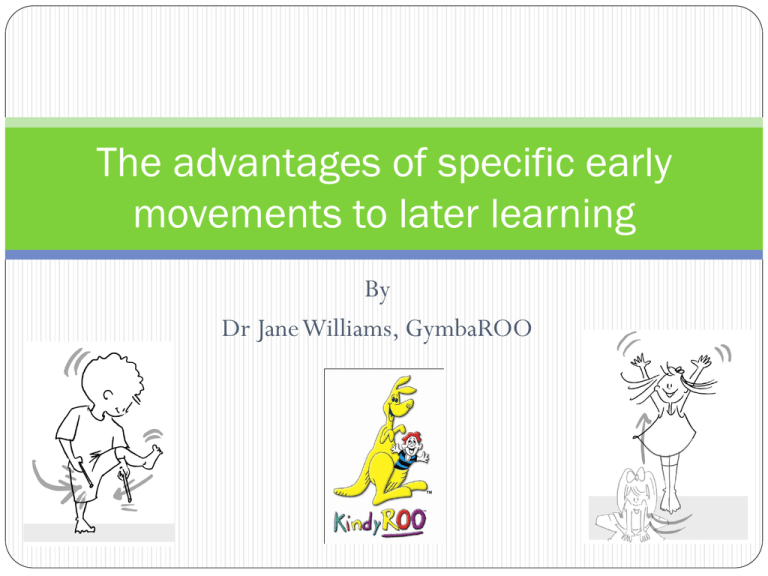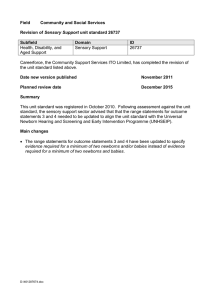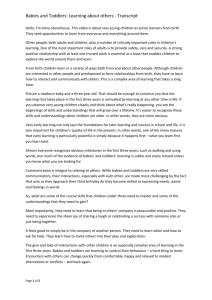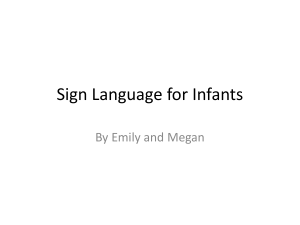Gymbaroo_Why movement is important to later learning_2012
advertisement

The advantages of specific early movements to later learning By Dr Jane Williams, GymbaROO Why movement is important to learning We know children need movement as it provides opportunities to: Stimulate the developing neuron connections in the brain Stimulate the senses - feeling, seeing, hearing, tasting, moving & balance Learn how to use muscles that control the body movements Coordinate sight with movement Encourage social skills Act out thoughts, emotions, roles Learn to solve problems..... And develop language 2 What children need to promote healthy development The brain needs nurturing & nourishing so that neurological growth and development can occur. 3 What children need to promote healthy development Massage Vestibular Movement through active play Exercise Nutrition Music Speech Low stress Free play & socialising Loving attention 4 Why children today are not moving Not as much play space for children to play Not as much moving play equipment Not as safe for our children to play outside Much more TV, computers and “sit down” time Much more driving, less walking, running, skipping Fear of SIDS - “Back to Sleep” campaign and reduced time on tummy for babies Lots of “containers” – designed to help parents but stops our babies and small children playing freely without restriction. 5 Why children today are not moving Image retrieved July 9, 2005 from http://www.slumbersounds.com/images/swaddleme150.jpg Image retrieved July 4, 2005 from http://www.healthchecksystems.com/images/chicco_polly_girl.jpg Image retrieved July 4, 2005 from http://imagescdn01.associatedcontent.com/150_00000 00621_0000079798.jpg For further research on “containerised children”, see Alice Brown, USQ. Image retrieved July 4, 2005 from http://www.shanni.org/gallery/albums/Twins/DSC01680.jpg 6 Children need to move to learn Babies and children who do not have LOTS of repeated opportunities to move are at risk of later learning problems. A large study in the UK (2009) identified that babies who were behind in motor development at 9 months were at risk of later learning problems. Several research studies show that children with learning problems at school are greatly assisted in their learning capabilities by specially designed movement programs (that are based on movements of babies). 7 Moving to learn: babies Babies need exercises, & movement experiences that stimulate sensory organs in the brain - visual, auditory, vestibular (balance), proprioceptive (movement of joints & muscles). These activities are more stimulating if accompanied by rhythm, songs & dance 8 Moving to learn: babies Play to utilise inbuilt reflexes to stimulate movement patterns of rolling, crawling, creeping. Tummy time for the non- movers Floor time for the creeper/crawlers Moving to learn: toddler play Toddlers require opportunities to play in ways that repetitively stimulate: motor action, motor planning and begin to integrate sensory, motor and thinking skills. 10 Moving to learn: toddlers Motor skill development is a primary aim of play in this age group: Movement that promotes hand-eye coordination, muscle tone, strength and agility, balance- running, climbing, creeping, hanging, rolling, tumbling, spinning Activities that allow a toddler to gain more control, skill & confidence - balance activities, jumping 11 Moving to learn: toddlers To fine tune movement, balance must also be refined: Rock, roll, swing, slide, spin, hang upside down, dance, bounce, do wheelbarrows. These help a child gain control over our their body and be able to cope with gravity, visual demands, sensory inputs. 12 Moving to learn: pre-schoolers Pre-schoolers need to engage in active play activities that consolidate and refine earlier skills and promote the development of thinking skills that are foundational to school readiness. 13 Moving to learn: pre-schoolers Cross pattern movements & 14 midline cross -over work 3 wheel scooting Hopping, marching, skipping Rebounder work Rhythm sticks Throwing, catching, batting, dancing The importance of movement Providing movement opportunities that enable the child to explore, develop, practice and refine skills is essential for healthy neurological development. Healthy neurological development underpins later social, emotional and academic success. 15 SMART START: by Margaret Sasse 185 fun movement and sensory activity ideas for parents of infants & children to preschool age. Help’s parents maximize the critical periods of brain development in the early years. 16 A final word “…if we truly wish to provide our children with an equal opportunity to maximize their potential, whatever that might be, it is vital that we do everything we can to enhance their early development.” (McCain, Mustard, & Shanker, 2007, p. 13). 17 References Twaddell, P. (2001). If you want to make a difference, intervene: the Australian Kindergarten Screening Instrument. Australian Journal of Learning Disabilities, 6(4), 26-35. Sims, Margaret (2008). Applying neurobiological evidence to caring for infants and toddlers. Presented at the Children’s Communities Connections Conference, UniSA, November 2008. Accessed from: http://www.salisburyc4c.org.au/resourcedownloads/Applying_Neurobiological_Evidence_to_Caring_for_ Infants_and_Toddlers.pdf Thelen, E. (2004). The central role of action in typical and atypical development. In: Movement and action in learning and development: clinical implications for pervasive developmental orders (Ed: I. Stockman), (pp. 49-73). Amsterdam: Elsevier Academic Press. Hart, B., Brinkman, S., & Blackmore, S. (2003). How well are we raising our children in the north metropolitan area? Results of the early development instrument. Perth: Population Health Program: North Metropolitan Health Service. 18



